CHCDIV001: Workplace Diversity in Healthcare - Strategies & Benefits
VerifiedAdded on 2023/06/08
|8
|1845
|214
Report
AI Summary
This report discusses workplace diversity within healthcare settings, emphasizing the importance of cultural sensitivity and inclusion. It identifies various types of diversity, including cultural backgrounds, linguistic differences, and gender diversity, and examines potential barriers such as negative attitudes and communication challenges. Strategies for proactive conflict resolution, such as promoting open communication, cultural awareness training, and the use of language interpreters, are explored. The report highlights the advantages of a diverse workforce, including improved patient care, enhanced creativity, and better understanding of diverse patient needs. Recommendations are provided for fostering a culturally safe and inclusive environment, including reviewing workplace policies, educating team members about cultural safety, and actively preventing discriminatory acts. The report concludes that embracing diversity leads to greater collaboration, innovation, and ultimately, improved patient satisfaction.
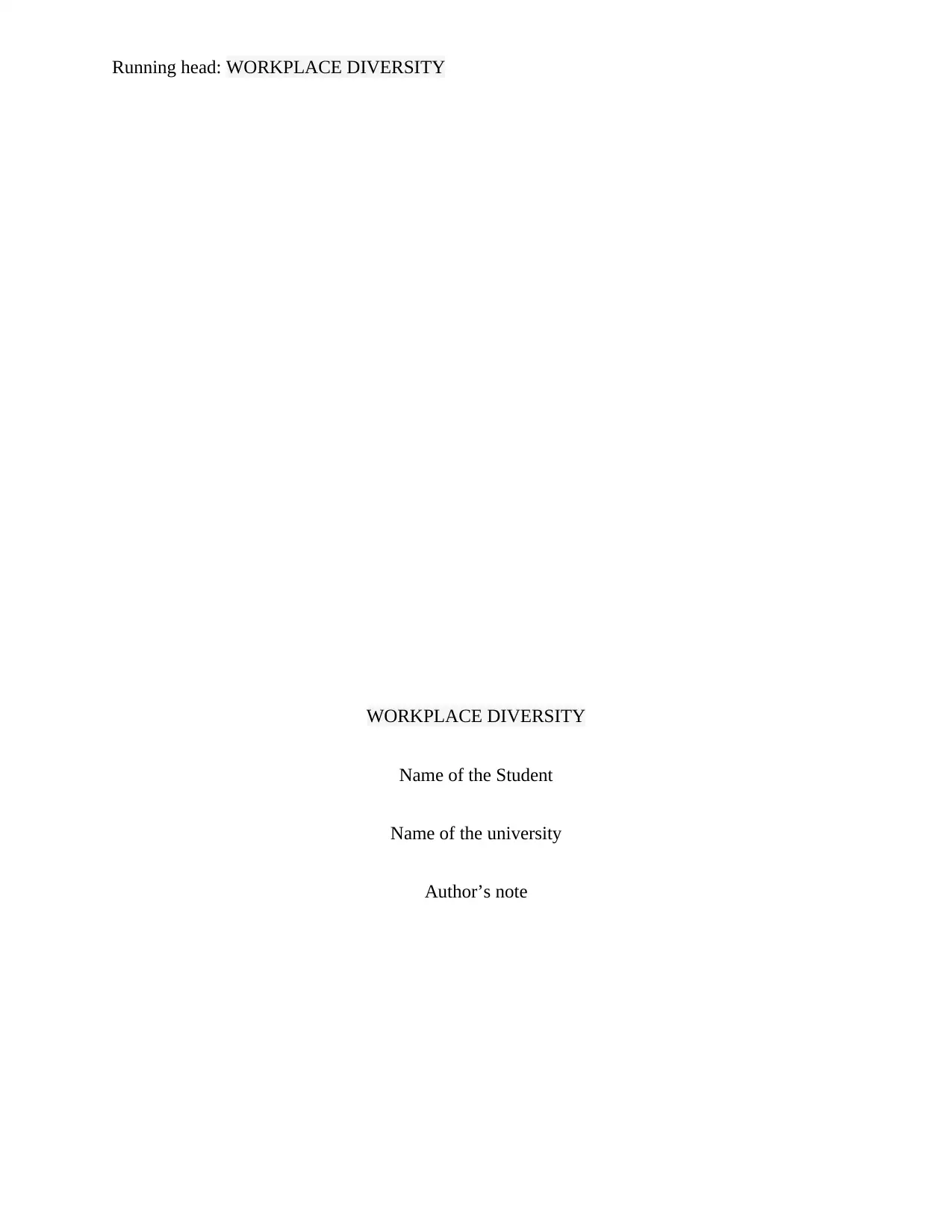
Running head: WORKPLACE DIVERSITY
WORKPLACE DIVERSITY
Name of the Student
Name of the university
Author’s note
WORKPLACE DIVERSITY
Name of the Student
Name of the university
Author’s note
Paraphrase This Document
Need a fresh take? Get an instant paraphrase of this document with our AI Paraphraser
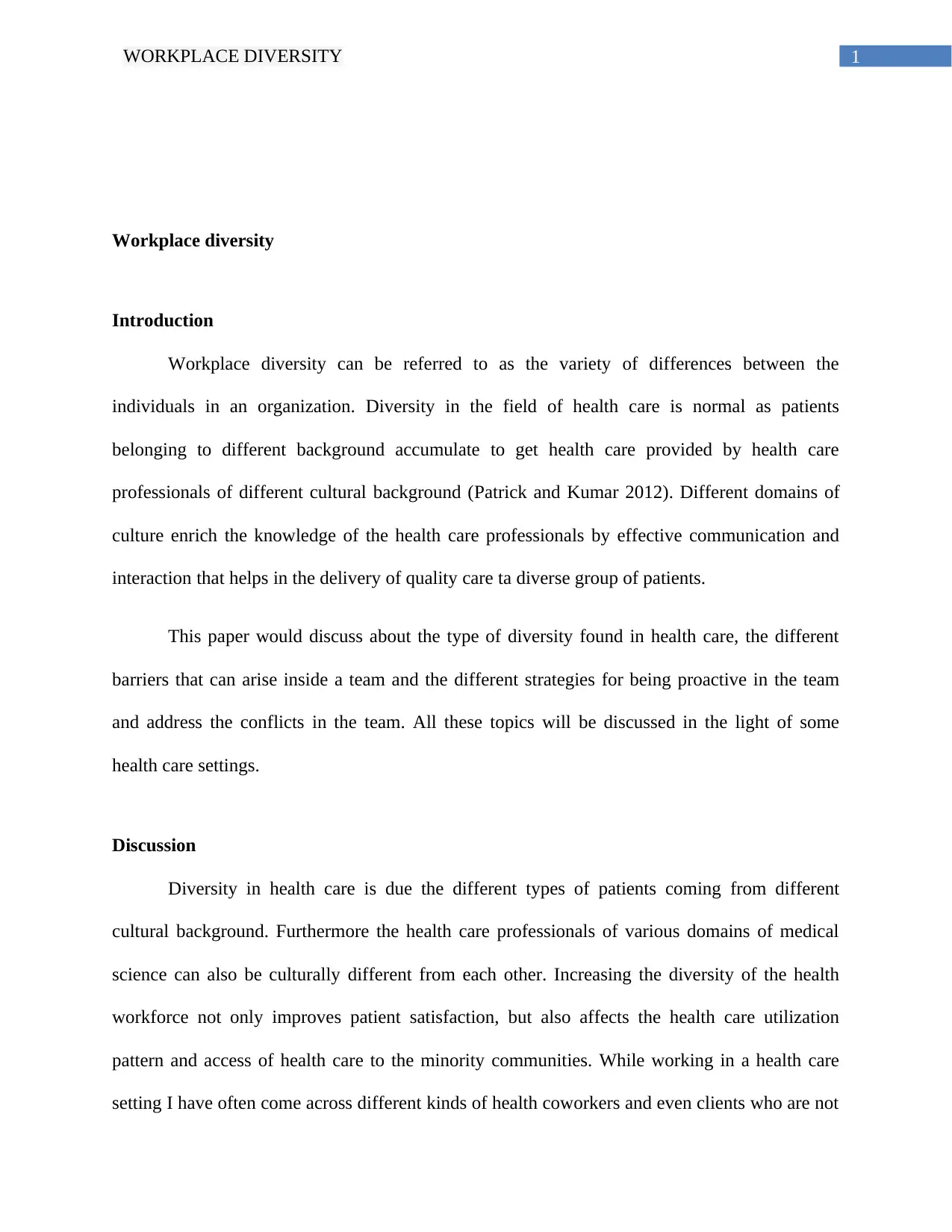
1WORKPLACE DIVERSITY
Workplace diversity
Introduction
Workplace diversity can be referred to as the variety of differences between the
individuals in an organization. Diversity in the field of health care is normal as patients
belonging to different background accumulate to get health care provided by health care
professionals of different cultural background (Patrick and Kumar 2012). Different domains of
culture enrich the knowledge of the health care professionals by effective communication and
interaction that helps in the delivery of quality care ta diverse group of patients.
This paper would discuss about the type of diversity found in health care, the different
barriers that can arise inside a team and the different strategies for being proactive in the team
and address the conflicts in the team. All these topics will be discussed in the light of some
health care settings.
Discussion
Diversity in health care is due the different types of patients coming from different
cultural background. Furthermore the health care professionals of various domains of medical
science can also be culturally different from each other. Increasing the diversity of the health
workforce not only improves patient satisfaction, but also affects the health care utilization
pattern and access of health care to the minority communities. While working in a health care
setting I have often come across different kinds of health coworkers and even clients who are not
Workplace diversity
Introduction
Workplace diversity can be referred to as the variety of differences between the
individuals in an organization. Diversity in the field of health care is normal as patients
belonging to different background accumulate to get health care provided by health care
professionals of different cultural background (Patrick and Kumar 2012). Different domains of
culture enrich the knowledge of the health care professionals by effective communication and
interaction that helps in the delivery of quality care ta diverse group of patients.
This paper would discuss about the type of diversity found in health care, the different
barriers that can arise inside a team and the different strategies for being proactive in the team
and address the conflicts in the team. All these topics will be discussed in the light of some
health care settings.
Discussion
Diversity in health care is due the different types of patients coming from different
cultural background. Furthermore the health care professionals of various domains of medical
science can also be culturally different from each other. Increasing the diversity of the health
workforce not only improves patient satisfaction, but also affects the health care utilization
pattern and access of health care to the minority communities. While working in a health care
setting I have often come across different kinds of health coworkers and even clients who are not
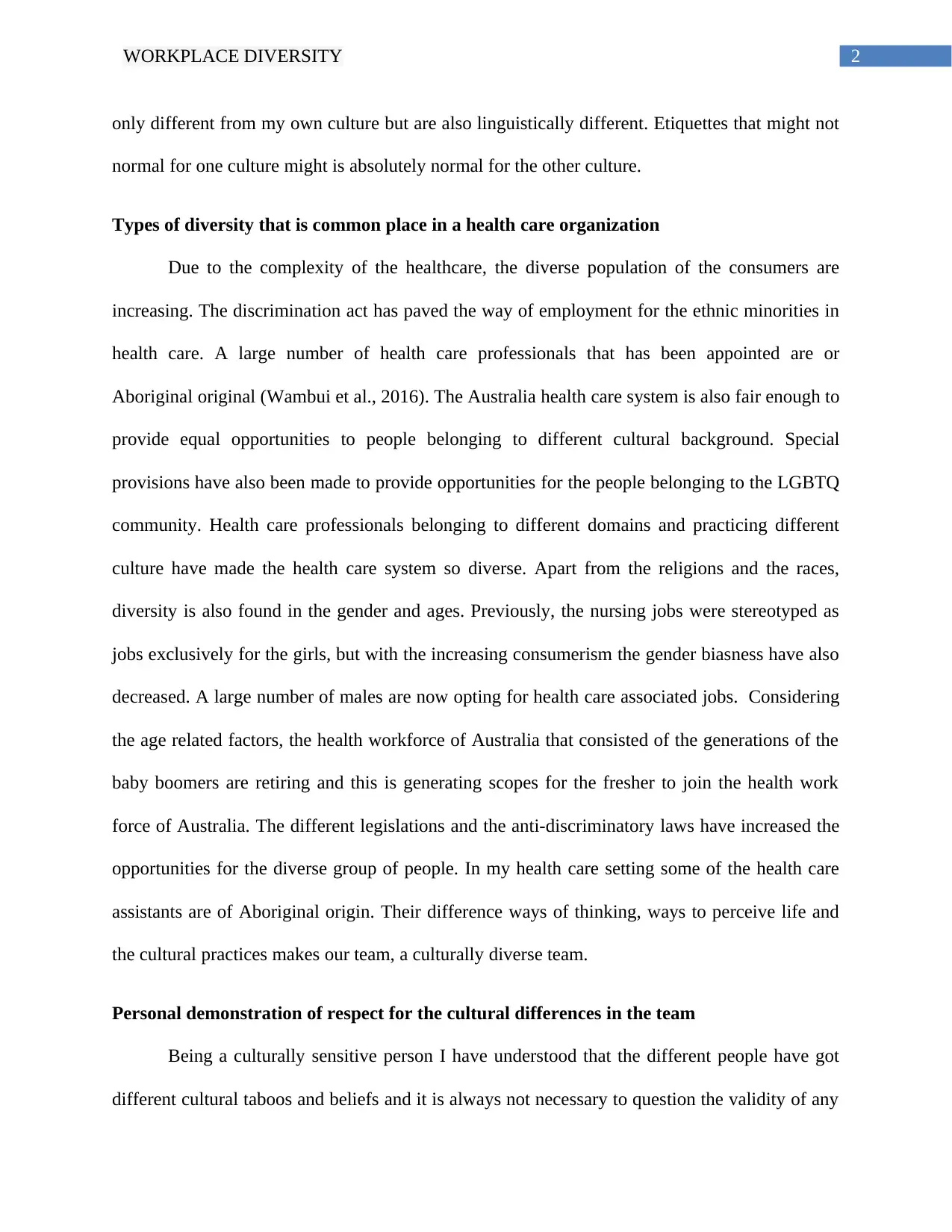
2WORKPLACE DIVERSITY
only different from my own culture but are also linguistically different. Etiquettes that might not
normal for one culture might is absolutely normal for the other culture.
Types of diversity that is common place in a health care organization
Due to the complexity of the healthcare, the diverse population of the consumers are
increasing. The discrimination act has paved the way of employment for the ethnic minorities in
health care. A large number of health care professionals that has been appointed are or
Aboriginal original (Wambui et al., 2016). The Australia health care system is also fair enough to
provide equal opportunities to people belonging to different cultural background. Special
provisions have also been made to provide opportunities for the people belonging to the LGBTQ
community. Health care professionals belonging to different domains and practicing different
culture have made the health care system so diverse. Apart from the religions and the races,
diversity is also found in the gender and ages. Previously, the nursing jobs were stereotyped as
jobs exclusively for the girls, but with the increasing consumerism the gender biasness have also
decreased. A large number of males are now opting for health care associated jobs. Considering
the age related factors, the health workforce of Australia that consisted of the generations of the
baby boomers are retiring and this is generating scopes for the fresher to join the health work
force of Australia. The different legislations and the anti-discriminatory laws have increased the
opportunities for the diverse group of people. In my health care setting some of the health care
assistants are of Aboriginal origin. Their difference ways of thinking, ways to perceive life and
the cultural practices makes our team, a culturally diverse team.
Personal demonstration of respect for the cultural differences in the team
Being a culturally sensitive person I have understood that the different people have got
different cultural taboos and beliefs and it is always not necessary to question the validity of any
only different from my own culture but are also linguistically different. Etiquettes that might not
normal for one culture might is absolutely normal for the other culture.
Types of diversity that is common place in a health care organization
Due to the complexity of the healthcare, the diverse population of the consumers are
increasing. The discrimination act has paved the way of employment for the ethnic minorities in
health care. A large number of health care professionals that has been appointed are or
Aboriginal original (Wambui et al., 2016). The Australia health care system is also fair enough to
provide equal opportunities to people belonging to different cultural background. Special
provisions have also been made to provide opportunities for the people belonging to the LGBTQ
community. Health care professionals belonging to different domains and practicing different
culture have made the health care system so diverse. Apart from the religions and the races,
diversity is also found in the gender and ages. Previously, the nursing jobs were stereotyped as
jobs exclusively for the girls, but with the increasing consumerism the gender biasness have also
decreased. A large number of males are now opting for health care associated jobs. Considering
the age related factors, the health workforce of Australia that consisted of the generations of the
baby boomers are retiring and this is generating scopes for the fresher to join the health work
force of Australia. The different legislations and the anti-discriminatory laws have increased the
opportunities for the diverse group of people. In my health care setting some of the health care
assistants are of Aboriginal origin. Their difference ways of thinking, ways to perceive life and
the cultural practices makes our team, a culturally diverse team.
Personal demonstration of respect for the cultural differences in the team
Being a culturally sensitive person I have understood that the different people have got
different cultural taboos and beliefs and it is always not necessary to question the validity of any
⊘ This is a preview!⊘
Do you want full access?
Subscribe today to unlock all pages.

Trusted by 1+ million students worldwide
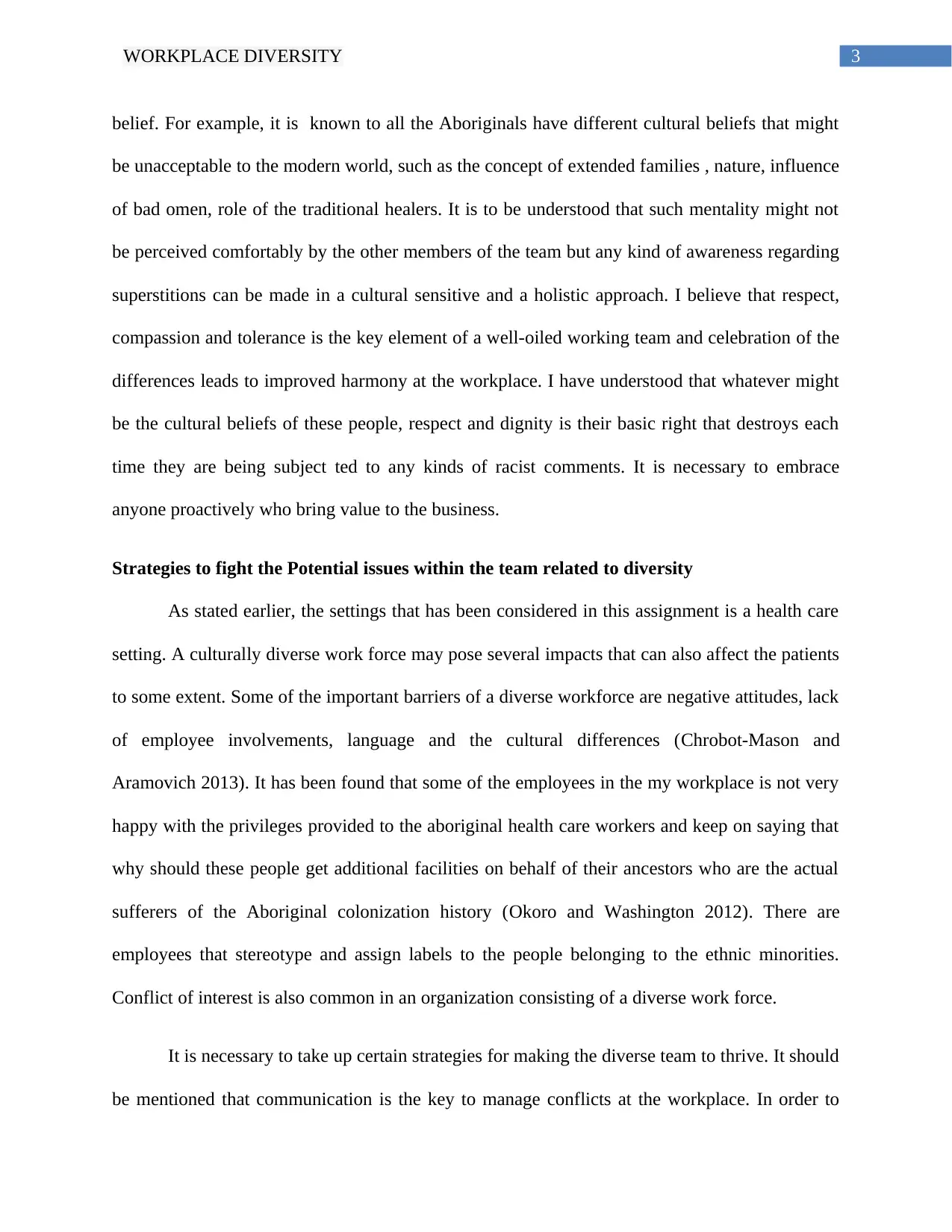
3WORKPLACE DIVERSITY
belief. For example, it is known to all the Aboriginals have different cultural beliefs that might
be unacceptable to the modern world, such as the concept of extended families , nature, influence
of bad omen, role of the traditional healers. It is to be understood that such mentality might not
be perceived comfortably by the other members of the team but any kind of awareness regarding
superstitions can be made in a cultural sensitive and a holistic approach. I believe that respect,
compassion and tolerance is the key element of a well-oiled working team and celebration of the
differences leads to improved harmony at the workplace. I have understood that whatever might
be the cultural beliefs of these people, respect and dignity is their basic right that destroys each
time they are being subject ted to any kinds of racist comments. It is necessary to embrace
anyone proactively who bring value to the business.
Strategies to fight the Potential issues within the team related to diversity
As stated earlier, the settings that has been considered in this assignment is a health care
setting. A culturally diverse work force may pose several impacts that can also affect the patients
to some extent. Some of the important barriers of a diverse workforce are negative attitudes, lack
of employee involvements, language and the cultural differences (Chrobot-Mason and
Aramovich 2013). It has been found that some of the employees in the my workplace is not very
happy with the privileges provided to the aboriginal health care workers and keep on saying that
why should these people get additional facilities on behalf of their ancestors who are the actual
sufferers of the Aboriginal colonization history (Okoro and Washington 2012). There are
employees that stereotype and assign labels to the people belonging to the ethnic minorities.
Conflict of interest is also common in an organization consisting of a diverse work force.
It is necessary to take up certain strategies for making the diverse team to thrive. It should
be mentioned that communication is the key to manage conflicts at the workplace. In order to
belief. For example, it is known to all the Aboriginals have different cultural beliefs that might
be unacceptable to the modern world, such as the concept of extended families , nature, influence
of bad omen, role of the traditional healers. It is to be understood that such mentality might not
be perceived comfortably by the other members of the team but any kind of awareness regarding
superstitions can be made in a cultural sensitive and a holistic approach. I believe that respect,
compassion and tolerance is the key element of a well-oiled working team and celebration of the
differences leads to improved harmony at the workplace. I have understood that whatever might
be the cultural beliefs of these people, respect and dignity is their basic right that destroys each
time they are being subject ted to any kinds of racist comments. It is necessary to embrace
anyone proactively who bring value to the business.
Strategies to fight the Potential issues within the team related to diversity
As stated earlier, the settings that has been considered in this assignment is a health care
setting. A culturally diverse work force may pose several impacts that can also affect the patients
to some extent. Some of the important barriers of a diverse workforce are negative attitudes, lack
of employee involvements, language and the cultural differences (Chrobot-Mason and
Aramovich 2013). It has been found that some of the employees in the my workplace is not very
happy with the privileges provided to the aboriginal health care workers and keep on saying that
why should these people get additional facilities on behalf of their ancestors who are the actual
sufferers of the Aboriginal colonization history (Okoro and Washington 2012). There are
employees that stereotype and assign labels to the people belonging to the ethnic minorities.
Conflict of interest is also common in an organization consisting of a diverse work force.
It is necessary to take up certain strategies for making the diverse team to thrive. It should
be mentioned that communication is the key to manage conflicts at the workplace. In order to
Paraphrase This Document
Need a fresh take? Get an instant paraphrase of this document with our AI Paraphraser
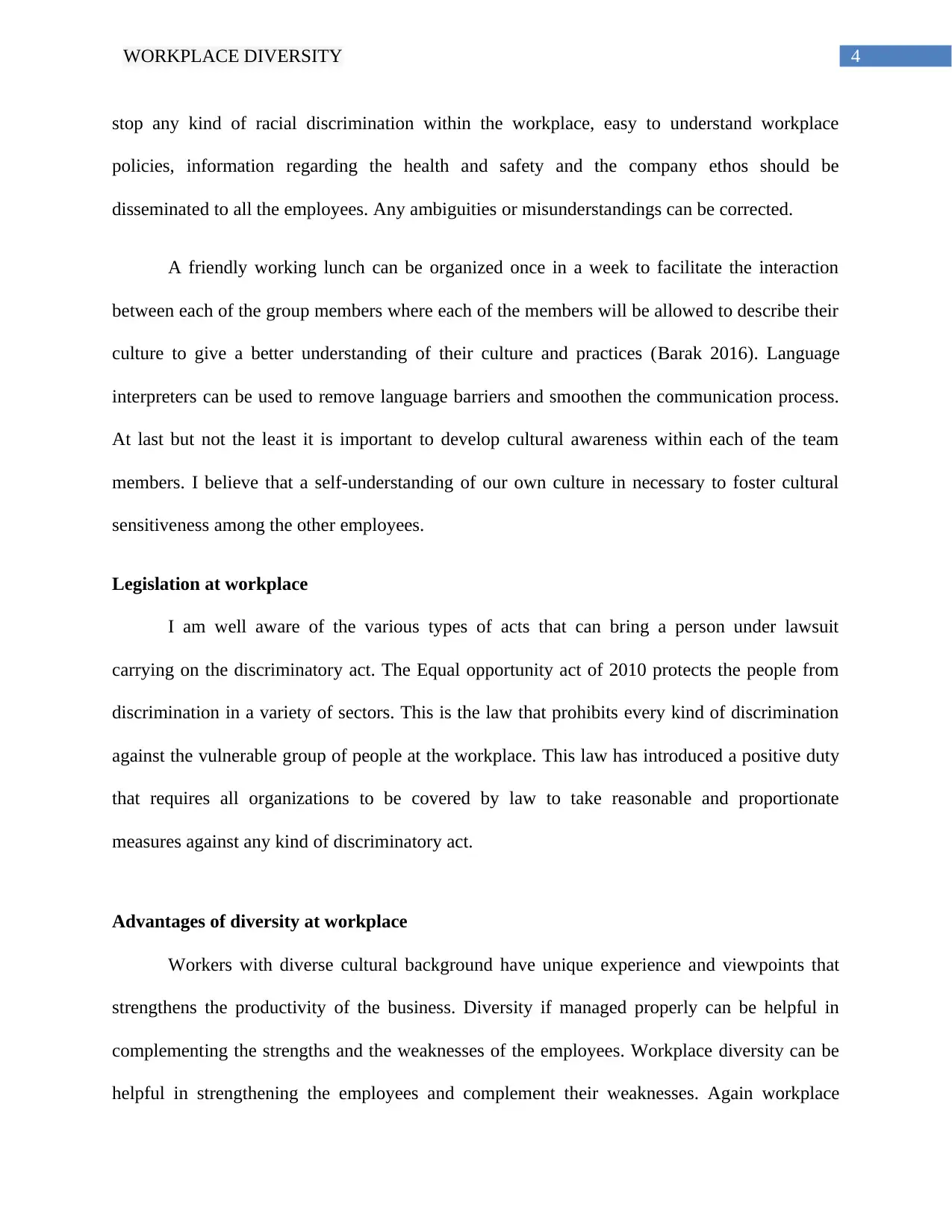
4WORKPLACE DIVERSITY
stop any kind of racial discrimination within the workplace, easy to understand workplace
policies, information regarding the health and safety and the company ethos should be
disseminated to all the employees. Any ambiguities or misunderstandings can be corrected.
A friendly working lunch can be organized once in a week to facilitate the interaction
between each of the group members where each of the members will be allowed to describe their
culture to give a better understanding of their culture and practices (Barak 2016). Language
interpreters can be used to remove language barriers and smoothen the communication process.
At last but not the least it is important to develop cultural awareness within each of the team
members. I believe that a self-understanding of our own culture in necessary to foster cultural
sensitiveness among the other employees.
Legislation at workplace
I am well aware of the various types of acts that can bring a person under lawsuit
carrying on the discriminatory act. The Equal opportunity act of 2010 protects the people from
discrimination in a variety of sectors. This is the law that prohibits every kind of discrimination
against the vulnerable group of people at the workplace. This law has introduced a positive duty
that requires all organizations to be covered by law to take reasonable and proportionate
measures against any kind of discriminatory act.
Advantages of diversity at workplace
Workers with diverse cultural background have unique experience and viewpoints that
strengthens the productivity of the business. Diversity if managed properly can be helpful in
complementing the strengths and the weaknesses of the employees. Workplace diversity can be
helpful in strengthening the employees and complement their weaknesses. Again workplace
stop any kind of racial discrimination within the workplace, easy to understand workplace
policies, information regarding the health and safety and the company ethos should be
disseminated to all the employees. Any ambiguities or misunderstandings can be corrected.
A friendly working lunch can be organized once in a week to facilitate the interaction
between each of the group members where each of the members will be allowed to describe their
culture to give a better understanding of their culture and practices (Barak 2016). Language
interpreters can be used to remove language barriers and smoothen the communication process.
At last but not the least it is important to develop cultural awareness within each of the team
members. I believe that a self-understanding of our own culture in necessary to foster cultural
sensitiveness among the other employees.
Legislation at workplace
I am well aware of the various types of acts that can bring a person under lawsuit
carrying on the discriminatory act. The Equal opportunity act of 2010 protects the people from
discrimination in a variety of sectors. This is the law that prohibits every kind of discrimination
against the vulnerable group of people at the workplace. This law has introduced a positive duty
that requires all organizations to be covered by law to take reasonable and proportionate
measures against any kind of discriminatory act.
Advantages of diversity at workplace
Workers with diverse cultural background have unique experience and viewpoints that
strengthens the productivity of the business. Diversity if managed properly can be helpful in
complementing the strengths and the weaknesses of the employees. Workplace diversity can be
helpful in strengthening the employees and complement their weaknesses. Again workplace
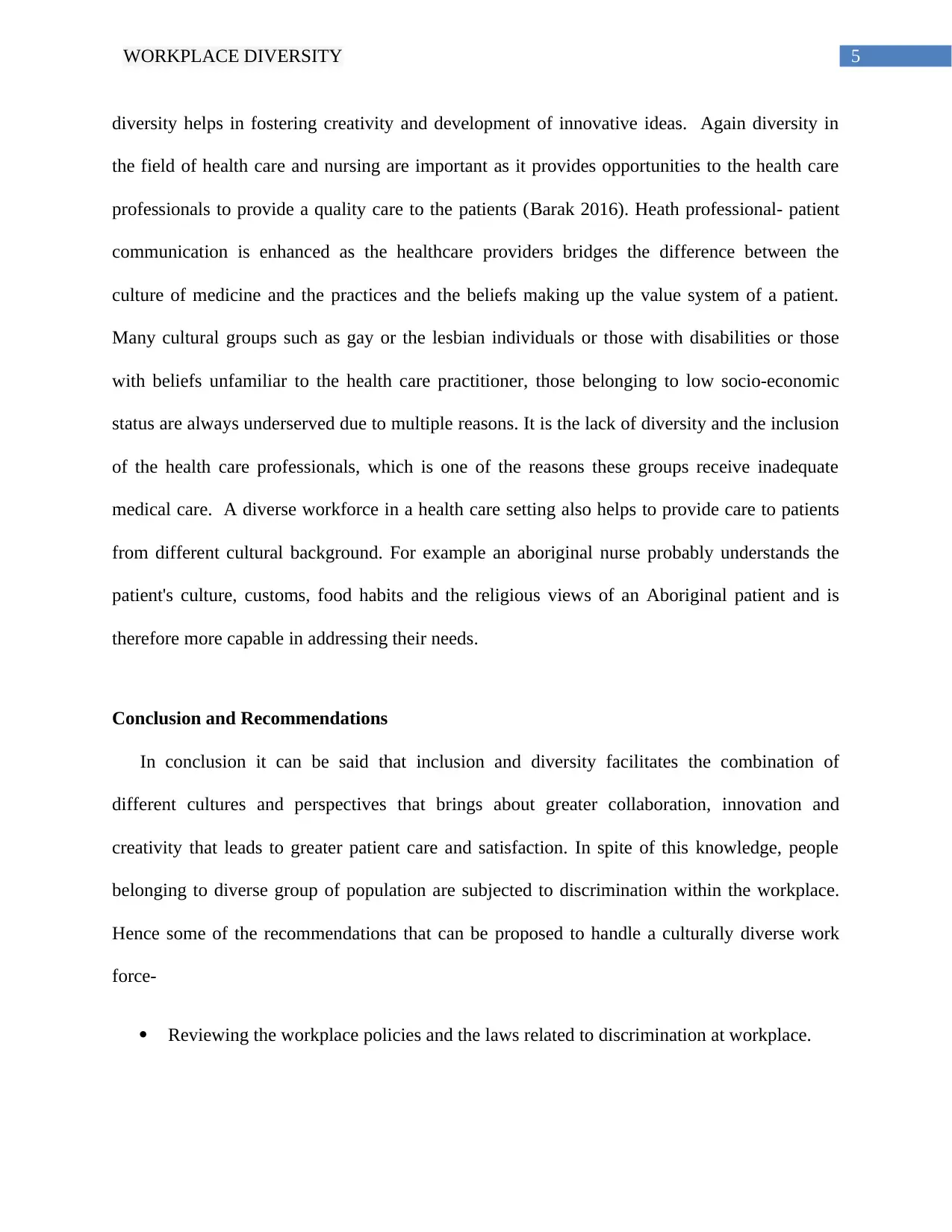
5WORKPLACE DIVERSITY
diversity helps in fostering creativity and development of innovative ideas. Again diversity in
the field of health care and nursing are important as it provides opportunities to the health care
professionals to provide a quality care to the patients (Barak 2016). Heath professional- patient
communication is enhanced as the healthcare providers bridges the difference between the
culture of medicine and the practices and the beliefs making up the value system of a patient.
Many cultural groups such as gay or the lesbian individuals or those with disabilities or those
with beliefs unfamiliar to the health care practitioner, those belonging to low socio-economic
status are always underserved due to multiple reasons. It is the lack of diversity and the inclusion
of the health care professionals, which is one of the reasons these groups receive inadequate
medical care. A diverse workforce in a health care setting also helps to provide care to patients
from different cultural background. For example an aboriginal nurse probably understands the
patient's culture, customs, food habits and the religious views of an Aboriginal patient and is
therefore more capable in addressing their needs.
Conclusion and Recommendations
In conclusion it can be said that inclusion and diversity facilitates the combination of
different cultures and perspectives that brings about greater collaboration, innovation and
creativity that leads to greater patient care and satisfaction. In spite of this knowledge, people
belonging to diverse group of population are subjected to discrimination within the workplace.
Hence some of the recommendations that can be proposed to handle a culturally diverse work
force-
Reviewing the workplace policies and the laws related to discrimination at workplace.
diversity helps in fostering creativity and development of innovative ideas. Again diversity in
the field of health care and nursing are important as it provides opportunities to the health care
professionals to provide a quality care to the patients (Barak 2016). Heath professional- patient
communication is enhanced as the healthcare providers bridges the difference between the
culture of medicine and the practices and the beliefs making up the value system of a patient.
Many cultural groups such as gay or the lesbian individuals or those with disabilities or those
with beliefs unfamiliar to the health care practitioner, those belonging to low socio-economic
status are always underserved due to multiple reasons. It is the lack of diversity and the inclusion
of the health care professionals, which is one of the reasons these groups receive inadequate
medical care. A diverse workforce in a health care setting also helps to provide care to patients
from different cultural background. For example an aboriginal nurse probably understands the
patient's culture, customs, food habits and the religious views of an Aboriginal patient and is
therefore more capable in addressing their needs.
Conclusion and Recommendations
In conclusion it can be said that inclusion and diversity facilitates the combination of
different cultures and perspectives that brings about greater collaboration, innovation and
creativity that leads to greater patient care and satisfaction. In spite of this knowledge, people
belonging to diverse group of population are subjected to discrimination within the workplace.
Hence some of the recommendations that can be proposed to handle a culturally diverse work
force-
Reviewing the workplace policies and the laws related to discrimination at workplace.
⊘ This is a preview!⊘
Do you want full access?
Subscribe today to unlock all pages.

Trusted by 1+ million students worldwide
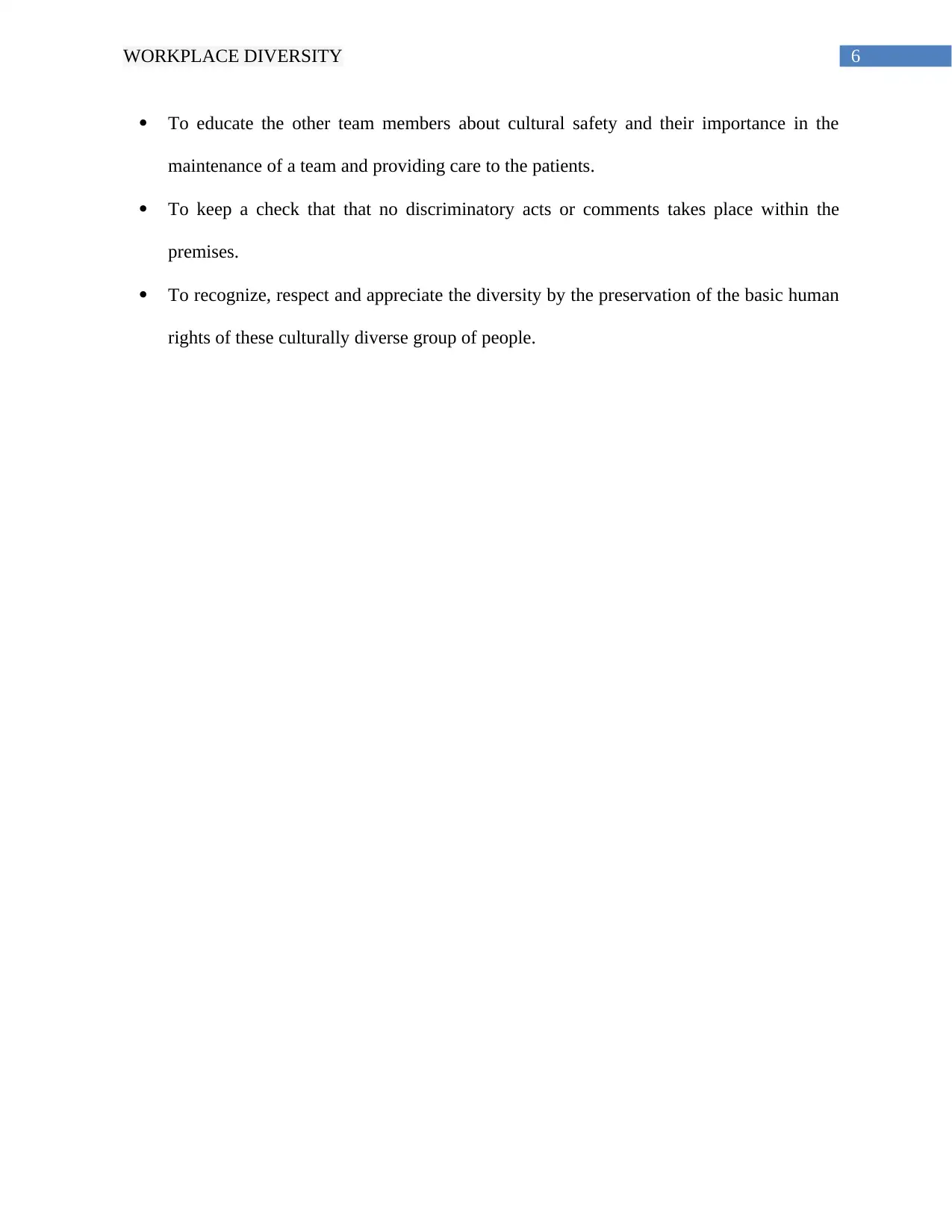
6WORKPLACE DIVERSITY
To educate the other team members about cultural safety and their importance in the
maintenance of a team and providing care to the patients.
To keep a check that that no discriminatory acts or comments takes place within the
premises.
To recognize, respect and appreciate the diversity by the preservation of the basic human
rights of these culturally diverse group of people.
To educate the other team members about cultural safety and their importance in the
maintenance of a team and providing care to the patients.
To keep a check that that no discriminatory acts or comments takes place within the
premises.
To recognize, respect and appreciate the diversity by the preservation of the basic human
rights of these culturally diverse group of people.
Paraphrase This Document
Need a fresh take? Get an instant paraphrase of this document with our AI Paraphraser
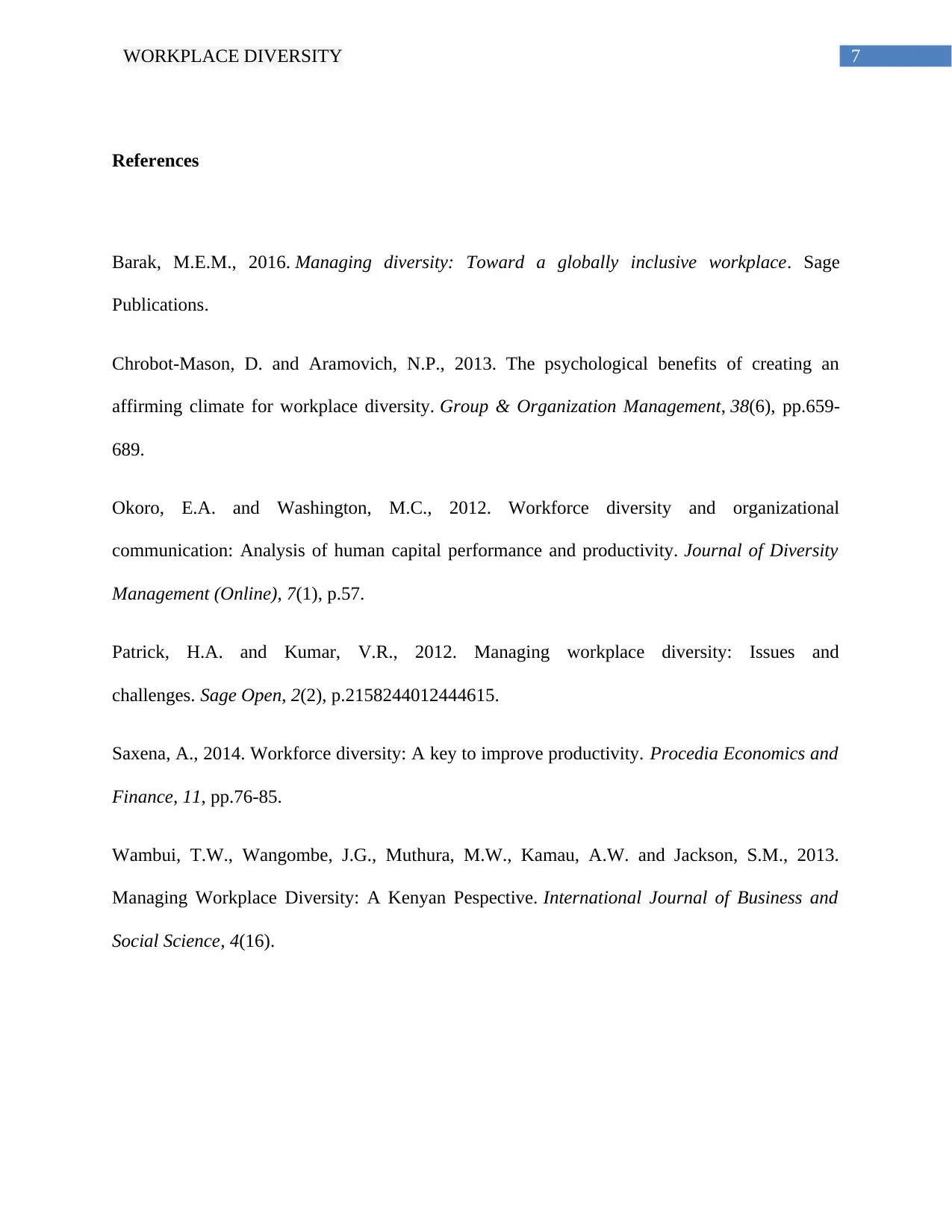
7WORKPLACE DIVERSITY
References
Barak, M.E.M., 2016. Managing diversity: Toward a globally inclusive workplace. Sage
Publications.
Chrobot-Mason, D. and Aramovich, N.P., 2013. The psychological benefits of creating an
affirming climate for workplace diversity. Group & Organization Management, 38(6), pp.659-
689.
Okoro, E.A. and Washington, M.C., 2012. Workforce diversity and organizational
communication: Analysis of human capital performance and productivity. Journal of Diversity
Management (Online), 7(1), p.57.
Patrick, H.A. and Kumar, V.R., 2012. Managing workplace diversity: Issues and
challenges. Sage Open, 2(2), p.2158244012444615.
Saxena, A., 2014. Workforce diversity: A key to improve productivity. Procedia Economics and
Finance, 11, pp.76-85.
Wambui, T.W., Wangombe, J.G., Muthura, M.W., Kamau, A.W. and Jackson, S.M., 2013.
Managing Workplace Diversity: A Kenyan Pespective. International Journal of Business and
Social Science, 4(16).
References
Barak, M.E.M., 2016. Managing diversity: Toward a globally inclusive workplace. Sage
Publications.
Chrobot-Mason, D. and Aramovich, N.P., 2013. The psychological benefits of creating an
affirming climate for workplace diversity. Group & Organization Management, 38(6), pp.659-
689.
Okoro, E.A. and Washington, M.C., 2012. Workforce diversity and organizational
communication: Analysis of human capital performance and productivity. Journal of Diversity
Management (Online), 7(1), p.57.
Patrick, H.A. and Kumar, V.R., 2012. Managing workplace diversity: Issues and
challenges. Sage Open, 2(2), p.2158244012444615.
Saxena, A., 2014. Workforce diversity: A key to improve productivity. Procedia Economics and
Finance, 11, pp.76-85.
Wambui, T.W., Wangombe, J.G., Muthura, M.W., Kamau, A.W. and Jackson, S.M., 2013.
Managing Workplace Diversity: A Kenyan Pespective. International Journal of Business and
Social Science, 4(16).
1 out of 8
Related Documents
Your All-in-One AI-Powered Toolkit for Academic Success.
+13062052269
info@desklib.com
Available 24*7 on WhatsApp / Email
![[object Object]](/_next/static/media/star-bottom.7253800d.svg)
Unlock your academic potential
Copyright © 2020–2025 A2Z Services. All Rights Reserved. Developed and managed by ZUCOL.





